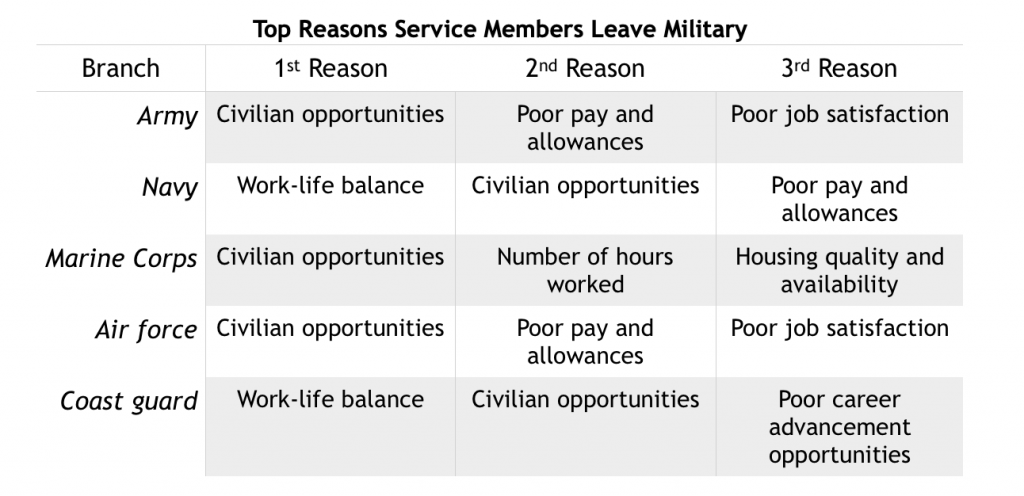
By Tyler Sylvia, 1stLT, USMC
Background
This paper provides information on the re-enlistment rates of the U.S. and NATO allies’ military services. It also examines the reasons and factors that contribute to why re-enlistment rates may be relatively high or low.
Key Findings
- Highest re-enlistment rate: Coast Guard ~68%
- Lowest re-enlistment rate: Marine Corps ~37%
- Top three reasons for enlisted service members to terminate active service across all branches:
- Civilian job opportunities or college
- Poor pay/allowances
- Overall job satisfaction
- Each branch consistently meets or exceeds yearly enlisted retention goals but continue to struggle to retain enlisted members with unique skills sets such as cyber operators, aviation maintenance mechanics, and special operation forces
- Multiple deployments, even to hostile areas, do not significantly impact on re-enlistment rates
- A tactic to retain more personnel, many NATO countries and U.S. military branches are considering some form of formal, extended departure from the military (up to one year) with the ability to return to the military if one so desires.
- NATO countries generally maintain sufficient levels of re-enlisted personal for the purposes for which their armed forces are designed.
U.S. Service Re-enlistment Comparison

Most Common Trends that Lead to Higher Re-enlistment Rates Across the Services
- Competitive re-enlistment bonuses
- Each branch offers substantial re-enlistment bonuses with the Army offering the most money – up to $100k
- The Army and the Air Force historically have the largest sum of money to offer per enlisted service member
- Job satisfaction – leadership opportunities and promotion potential
- All branches, in general, have appropriately planned to allow for timely promotions and appropriate billet openings for enlisted personnel
- Effective implementation of lateral occupational specialty move programs
Trends that Lead to Lower Re-enlistment Rates

- Civilian opportunities (to include college)
- The military offers highly sought-after training that often translates well to the civilian sector
- Utilization of GI bill
- Poor quality of life
- Amount of pay/allowances being the most common factor for poor quality of life
- High number of work hours in comparison to monetary compensation
- Poor barracks/housing options
- Notably, in the Marine Corps, one must be an E-6 to move out of the barracks compared to the other branches where (depending on base restrictions) one can be an E-5 to move out of the barracks.
- Desire to not PCS or deploy on regular basis
- Poor command culture/leadership
- Tied closely to job and work-place satisfaction
U.S. Services Compared to NATO Allies


- Denmark conscripts 18-year-old males. However, 96%-99% of service members are volunteers. The Danish do not have significant problems retaining its enlisted.
- Iceland does not maintain a military, rather, it has a small Coast Guard for defensive operations only
- Turkey has a very unique military recruitment and retention mechanism. Key points:
- Individuals selected to be NCOs sign a 15-year contract
- Conscripts who complete their obligated service can sign another contract for 1 – 5 years depending on desire and job
- NATO countries face very similar problems compared to the United States in terms of retaining enlisted personnel. The only notable exceptions are listed below:
- Incongruence between prevailing social values and the Military organizational culture
- Promotions systems based on seniority vice merit
- The management of the major processes of recruitment, selection and classification, turnover and retention
References
- Athey, P (2019, Octover 3). Marine Commandant Considers Major Changes to Improve Force Retention. Marine Corps Times. Retrieved from https://www.marinecorpstimes.com/news/2019/10/03/marine-commandant-considers-major-changes-to-improve-force-retention/
- Brading, T. (2019, June 26). Army Retention Hits Goal Five Months Early. Army News Service. Retrieved from https://www.army.mil/article/223295/army_retention_hits_goal_five_months_early
- Cohen, R. S. (2019, Oct 4). USAF Hits 2019 Personnel Goals, Facing Retention Ripple Effect. Air Force Magazine. Retrieved from https://www.airforcemag.com/USAF-Hits-2019-Personnel-Goals-Facing-Retention-Ripple-Effects/
- Department of Defense Announces Fiscal Year 2018 Recruiting and Retention Numbers — End
- of Year Report. (2018). U.S. Department of Defense. Retrieved from https://www.defense.gov/Newsroom/Releases/Release/Article/1691314/department-of-defense-announces-fiscal-year-2018-recruiting-and-retention-numbe/
- Dickerson, T. (2016). United States Coast Guard 2016 Annual EEO Program Status Report. Retrieved from https://www.uscg.mil/Portals/0/Headquarters/civilrights/PDFs/reports/MD715Report_files/MD7152016.pdf
- Faram, M. D. (2019, March 4). Why Big Navy Wants to do More to Retain Sailors. Navy Times.
- Retrieved from https://www.navytimes.com/news/your-navy/2019/03/04/why-big-navy-wants-to-do-more-to-retain-sailors/
- FY 2016 EAS Enlisted Retention Survey Results, Headquarters Marine Corps. Retrieved from https://www.hqmc.marines.mil/Portals/61/FY16%20ERS%20Final.pdf?ver=2016-07-14-141912-647
- Kapp, L. (2019). Defense Primer: Active Duty Enlisted Retention. Congressional Research Service, Pages 1 – 2.
- Losey, S. (2018, Sept 28). Air Force Ups Maximum Retention Bonus to $100k, Plans Big Expansion. Air Force Times. Retrieved from https://www.airforcetimes.com/news/your-air-force/2018/09/28/air-force-ups-maximum-retention-bonus-to-100k-plans-big-expansion/
- Losey, S. (2019, November 21). Air Force Steeply Cuts Retention Bonuses as Growth Improves – But You Still Have a Shot to Cash in. Retrieved from https://www.airforcetimes.com/news/your-air-force/2019/11/21/air-force-steeply-cuts-retention-bonuses-as-growth-improves-but-you-still-have-a-shot-to-cash-in/
- Overview of the 2000 Military Exit Survey. (2000). Department of Defense. Retrieved from https://www.esd.whs.mil/Portals/54/Documents/FOID/Reading%20Room/Personnel_Related/2000_MES.pdf
- Recruiting and Retention of Military Personnel (2007, October). Research and Technology Corporation.
- Reynolds, G. M. and Shendruk A. (2018, April 24). Demographics of the U.S. Military. Coucil on Foreign Relations. Retrieved from https://www.cfr.org/article/demographics-us-military
- Sanborn, J. K. (2015, May). First-Term Marines are Slow to Sign on for Another Enlistment. Marine Corps Times. Retrieved from https://www.marinecorpstimes.com/news/your-marine-corps/2015/10/12/first-term-marines-are-slow-to-sign-on-for-another-enlistment/
- Strategy Needed to Improve Retention of Experienced Air Force Aircraft Maintainers (2019, February 5). U.S. Government Accountability Office. Retreived from https://www.gao.gov/products/GAO-19-160
- Summary of the National Reports of NATO Member and Partner Nations to the NATO Committee on Gender Perspectives (2016). NATO.
